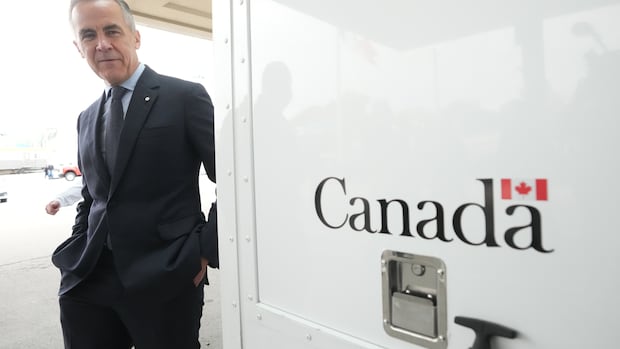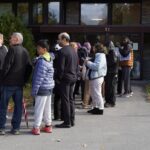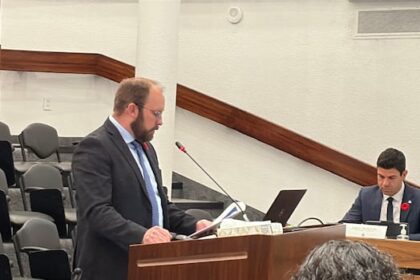Politics·AnalysisFive days before Donald Trump was inaugurated, Justin Trudeau gathered the premiers to discuss the coming crisis. Seated to Trudeau’s right, Ontario Premier Doug Ford said it was “truly a Team Canada approach we’re taking.” Almost exactly nine months later, it is harder to see a united front. Can Prime Minister Mark Carney keep everyone on the same page?Aaron Wherry · CBC News · Posted: Oct 19, 2025 4:00 AM EDT | Last Updated: 27 minutes agoPrime Minister Mark Carney walks by a Canada Border Services Agency vehicle at the Rainbow Bridge border crossing in Niagara Falls, Ont., on Friday, Oct. 17, 2025. (The Canadian Press)Five days before the new president was inaugurated, Justin Trudeau gathered the premiers in Ottawa to discuss the coming crisis. They emerged, Trudeau said, with a “shared sense of purpose, a shared sense of understanding and a commitment to stand together on a united path forward.” Seated to Trudeau’s right, Ontario Premier Doug Ford said it was “truly a Team Canada approach we’re taking.”The assembled first ministers didn’t agree on everything. Alberta Premier Danielle Smith was notably unwilling to consider a surcharge on oil exports to the United States. But Ford offered a thoughtful — perhaps even inspiring — take on the display of some broader political unity.”Isn’t this great that we have three political parties sitting down and we have a robust conversation — we may agree or disagree — but we’re coming out united?” Ford said. “I can tell ya, spending a lot of time in the U.S., you would never see a group of Democrats and Republicans sitting here collaboratively.” Almost exactly nine months later, it is perhaps harder to see a truly united front.British Columbia Premier David Eby recently suggested his province’s softwood lumber industry was due the same attention as Ontario’s auto industry, while the leader of Canada’s largest union has suggested the auto industry is running second to the steel and aluminum sectors.Manitoba Premier Wab Kinew and Saskatchewan Premier Scott Moe have called on the federal government to lift tariffs on electric vehicles from China, in hopes that China will then lift its tariffs on canola. But Ford, fearing for the impact on the domestic vehicle production, says there’s “no damn way” the tariff on Chinese EVs should be lifted.WATCH | Eby calls for support from Ottawa:B.C. premier calls on Ottawa to treat lumber tariffs as national emergencyB.C. Premier David Eby says Canadian lumber now faces higher tariffs going into the U.S. than lumber from Russia, and the higher tariffs going into effect must be treated by Ottawa like a national emergency. Eby has forcefully questioned the wisdom of Danielle Smith’s decision to push for a pipeline across northern B.C., while Smith has said Eby’s comments are “un-Canadian” (for good measure, former Alberta premier Jason Kenney says Eby is a threat to national unity).Meanwhile, Ford has openly questioned the federal government’s approach to negotiations with the United States and continues to push for the federal government to take more aggressive action in response to American tariffs.”Maybe Prime Minister Carney knows something I don’t know,” Ford said on the day Carney went to Washington to meet with President Donald Trump, “and if that’s the case he should sit down with the premiers and explain that.”Some of this angst might be understandable — or at least predictable. But it also might represent a burgeoning problem for Carney and country.Bringing together disparate interestsAny large, diverse nation is going to contain different and sometimes differing interests. The trade actions taken by the United States — and China — are impacting different sectors of the economy in different ways. And political leaders will naturally be inclined to champion the interests they represent.Premiers Eby, Smith, Moe, Kinew and Ford are each, in their own way, doing just that — speaking up, as they see fit, for the welfare of their constituents. It’s hard to argue that they could or should completely refrain from doing so. But it’s also necessary to ask whether these public divisions make it harder for Canadian negotiators to hold the line against American demands. At the very least, it’s hard to see how public divisions help the cause.Ford’s comments — that the prime minister might know something he doesn’t — sounded like an implicit invitation to Carney to set up more conference calls with the premiers (Carney and Ford met privately in Toronto on Thursday). If anything, the last few weeks might strengthen the case for more regular meetings of the first ministers.But federal outreach may need to extend beyond the provincial capitals.WATCH | At Issue: Cracks in Team Canada:At Issue | Cracks in Canada’s united front on tariffsAt Issue this week: How will the federal government keep a united front as tariff turmoil pits premiers against each other? The Liberals move on bail reform. And Pierre Poilievre accuses the RCMP of protecting Justin Trudeau from criminal charges.”I think what we’re seeing is province being pitted against province, sector against sector, worker against worker,” Unifor national president Lana Payne told CBC’s Power & Politics this week. “And I do believe that an approach to make sure that there is a table where people are part of a process needs to occur … we have to get people back on the same page.”Payne is already a member of the prime minister’s council of Canada-U.S. relations, established by Trudeau in January. A similar advisory council was created as part of the Trudeau government’s approach to NAFTA renegotiations. Each brought together representatives from industry and organized labour, as well as former political leaders of different party stripes. Payne’s predecessor, Jerry Dias, was not officially part of the NAFTA council, but Trudeau’s office kept him close during the renegotiation — and he became a prominent voice in the public discussion around those trade talks.Such efforts might seem secondary or superfluous, but communication and collaboration can at least build trust — and minimize public disagreements.The first job of a prime ministerIt is sometimes said that a prime minister’s first job is national unity — an idea most easily associated with the internal tensions that have always pulled at the seams of the country. In the current situation, the threat is external. And that has already shown the potential to bring Canadians together.”As the world is becoming more divided and dangerous, Canadians are uniting,” Carney said on Canada Day this year.But pressure can just as easily expose points of weakness. And right now the country is under a lot of pressure — pressure that is unlikely to quickly or easily abate. The responsibility for holding the whole thing together is shared by leaders at all levels — even premiers have to consider their counterparts, But it rests most heavily with the prime minister. And the more united the country’s leaders are, the easier it might be for Carney to fulfill his second and third jobs — negotiating with the American behemoth and fundamentally reorienting the Canadian economy to deal with a changed world.ABOUT THE AUTHORAaron Wherry has covered Parliament Hill since 2007 and has written for Maclean’s, the National Post and the Globe and Mail. He is the author of Promise & Peril, a book about Justin Trudeau’s years in power.
Thursday, 4 Dec 2025
Canada – The Illusion
Search
Have an existing account?
Sign In
© 2022 Foxiz News Network. Ruby Design Company. All Rights Reserved.
You May also Like
- More News:
- history
- Standing Bear Network
- John Gonzalez
- ᐊᔭᐦᑊ ayahp — It happened
- Creation
- Beneath the Water
- Olympic gold medal
- Jim Thorpe
- type O blood
- the bringer of life
- Raven
- Wás’agi
- NoiseCat
- 'Sugarcane'
- The rivers still sing
- ᑲᓂᐸᐏᐟ ᒪᐢᑿ
- ᐅᑳᐤ okâw — We remember
- ᐊᓂᓈᐯᐃᐧᐣ aninâpêwin — Truth
- This is what it means to be human.
- Nokoma












